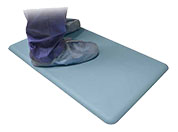
3 considerations when designing decontamination spaces
When designing decontamination spaces in SPD, staff safety, compliance to standards and guidelines, and minimizing cross-contamination are critical elements to determine an appropriate workflow.
ANSI/AAMI ST79:2017, 3.2.1.1 states “the physical design of the sterile processing department/area should support safe patient care, workplace safety, and security.”1 Additionally, workflow patterns should take into account methods to improve efficiency.
When designing a decontamination area, central sterile processing departments need to consider three design elements:
- Location of the decontamination area
- Manual cleaning equipment requirements
- Staff safety
1. Location of the decontamination area
ANSI/AAMI ST79:2017, 3.3.6 states that “the decontamination room should be physically separate from all other processing areas and from areas in which clean or sterilization procedures are carried out, with any connecting doors and pass-through windows remaining closed.” It should also be accessible from a “service corridor” and have “a door providing access to the clean workroom,” or a pass-through window for instruments that have been manually decontaminated.
The design of the decontamination room must consider that airborne contamination is high in the decontamination area. When instruments are being cleaned, aerosols are often produced that can pass indiscriminately to environmental surfaces, other instruments or staff. Enclosing the decontamination area is necessary to prevent contamination into the “clean” areas by air and surface transport.
2. Manual cleaning equipment requirements
Healthcare reprocessing sinks should have three sections or basins that are approximately 36 inches high and 8 to 10 inches deep. The sinks should include solid countertops or work surfaces in which technicians can place soiled and clean instruments separately. The basins should be large enough to allow instrument trays or baskets to be placed flat for manual cleaning. There should be two sink basins dedicated to soaking and rinsing prior to manual cleaning.
3.3.6.1.1 also recommends fixtures to prevent the accumulation of dust or soil. When reprocessing sinks utilize angled backsplashes, basin wrist rests, and basin marine edges, dust and liquids are not allowed to accumulate and also pull those contaminated liquids away from technicians.
3. Staff safety
Ergonomic considerations are also important when designing decontamination spaces to provide safety and comfort to your most important asset: your staff. ANSI/AAMI ST79: 2017, 3.3.6.1.3 states that decontamination spaces should include: Adjustable… sinks… positioned at heights that take into account the average height of the employees and the tasks to be performed… And anti-fatigue mats, constructed of materials capable of withstanding frequent cleaning, in areas where prolonged standing is required. By considering the needs of your staff during the design phase, departments can help prevent worker injury while also improving employee satisfaction. When staff are able to work comfortably and without pain, they are more likely to pay greater attention to manual cleaning tasks, in turn, improving patient safety.
Height-adjustable reprocessing sinks are also ‘future-proof’ against high turnover. Stationary or non-adjustable sinks can be a quick fix for the average height of a department’s technician today but can become obsolete when a department has turned over its employee base in 3-5 years.
By considering location of the decontamination area, manual cleaning equipment requirements, and staff safety, design of decontamination areas will be safer, efficient, and equipment will be easier to maintain.
Learn about Puresteel Healthcare Reprocessing Sinks and how the sink design meets compliance to effectively and efficiently manually clean surgical instruments. GelPro Eco-Pro NewLife Anti-Fatigue Mats also meet ergonomic compliance while helping staff maintain energy throughout their shifts.
References
- Association For The Advancement Of Medical Instrumentation. Sterilization Standards Committee, Association For The Advancement Of Medical Instrumentation, & American National Standards Institute. (2017). Comprehensive guide to steam sterilization and sterility assurance in health care facilities. Arlington, Va: Association For The Advancement Of Medical Instrumentation.




